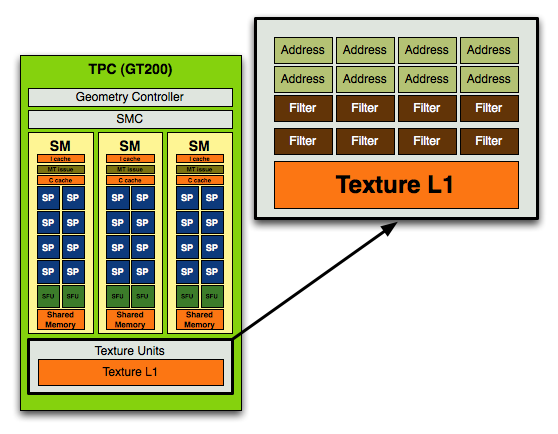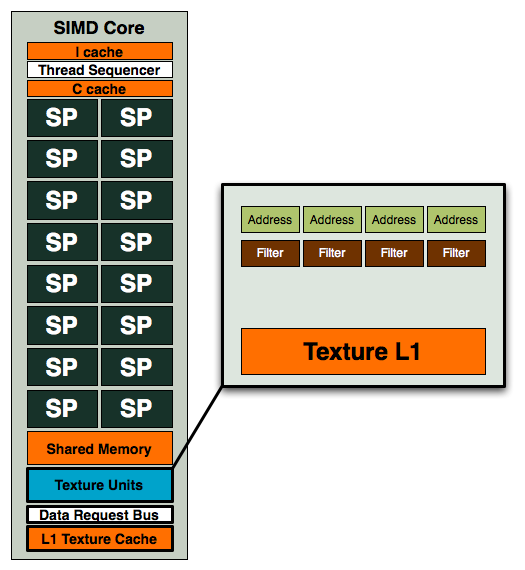The Radeon HD 4850 & 4870: AMD Wins at $199 and $299
by Anand Lal Shimpi & Derek Wilson on June 25, 2008 12:00 AM EST- Posted in
- GPUs
That Darn Compute:Texture Ratio
With its GT200 GPU, NVIDIA increased compute resources by nearly 90% but only increased texture processing by 25%, highlighting a continued trend in making GPUs even more powerful computationally. Here's another glance at the GT200's texture address and filter units:

Each TPC, of which there are 10, has eight address and eight filter units. Now let's look at RV770:

Four address and four filter units, while AMD maintains the same 1:1 address-to-filter ratio that NVIDIA does, the ratio of compute-to-texture in RV770 is significantly higher.
| AMD RV770 | AMD RV670 | NVIDIA GT200 | NVIDIA G92 | |
| # of SPs | 160 | 64 | 240 | 128 |
| Texture Address/Filter Units | 40 / 40 | 16 / 16 | 80 / 80 | 64 / 64 |
| Compute to Texture Ratio | 4:1 | 4:1 | 3:1 | 2:1 |
The table above illustrates NVIDIA's trend of increasing the compute to texture ratio from 2:1 in G92 to 3:1 in GT200. AMD arguably overshot with RV670 and its 4:1 ratio and thus didn't need to adjust it with RV770. Even while staying still at 4:1 with RV770, AMD's ratio is still more aggressively geared towards compute than NVIDIA's is. That does mean that more texture bound games will do better on NVIDIA hardware (at least proportionally), while more compute intensive games may do better on RV770.
AMD did also make some enhancements to their texture units as well. By doing some "stuff" that they won't tell us about, they improved the performance per mm^2 by 70%. Texture cache bandwidth has also been doubled to 480 GB/s while bandwidth between each L1 cache and L2 memory is 384 GB/s. L2 caches are aligned with memory channels of which there are four interleaved channels (resulting in 8 L2 caches).
Now that texture units are linked to both specific SIMD cores and individual L1 texture caches, we have an increase in total texturing ability due to the increase in SIMD cores with RV770. This gives us a 2.5x increase in the number of 8-bit per component textures we can fetch and bilinearly filter per clock, but only a 1.25x increase in the number of fp16 textures (as fp16 runs at half rate and fp32 runs at one quarter rate). It was our understanding that fp16 textures could run at full speed on R600, so the 1.25x increase in performance for half rate texturing of fp16 data makes sense.
Even though fp32 runs at quarter rate, with the types of texture fetches we would need to do, AMD says that we could end up being external memory bandwidth bound before we are texture filtering hardware bound. If this is the case, then the design decision to decrease rates for higher bit-depth textures makes sense.
| AMD RV770 | AMD RV670 | |
| L1 Texture Cache | 10 x 16KB (160KB total) | 32KB |
| L2 Texture Cache | I can has cache size? | 256KB |
| Vertex Cache | ? | 32KB |
| Local Data Share | 16KB | None |
| Global Data Share | 16KB | ? |
Even though AMD wouldn't tell us L1 cache sizes, we had enough info left over from the R600 time frame to combine with some hints and extract the data. We have determined that RV770 has 10 distinct 16k caches. This is as opposed to the single shared 32k L1 cache on R600 and gives us a total of 160k of L1 cache. We know R600's L2 cache was 256k, and AMD told us RV770 has a larger L2 cache, but they wouldn't give us any hints to help out.










215 Comments
View All Comments
DerekWilson - Wednesday, June 25, 2008 - link
it looks like the witcher hits an artificial 72fps barrier ... not sure why as we are running 60hz displays, but that's our best guess. vsync is disabled, so it is likely a software issue.JarredWalton - Wednesday, June 25, 2008 - link
Again, try faster CPUs to verify whether you are game limited or if there is a different bottleneck. The Witcher has a lot of stuff going on graphically that might limit frame rates to 70-75 FPS without a 4GHz Core 2 Duo/Quad chip.chizow - Wednesday, June 25, 2008 - link
It looks like there seems to be a lot of this going on in the high-end, with GT200, multi-GPU and even RV770 chips hitting FPS caps. In some titles, are you guys using Vsync? I saw Assassin's Creed was frame capped, is there a way to remove the cap like there is with UE3.0 games? It just seems like a lot of the results are very flat as you move across resolutions, even at higher resolutions like 16x10 and 19x12.Another thing I noticed was that multi-GPU seems to avoid some of this frame capping but the single-GPUs all still hit a wall around the same FPS.
Anyways, 4870 looks to be a great part, wondering if there will be a 1GB variant and if it will have any impact on performance.
DerekWilson - Wednesday, June 25, 2008 - link
the only test i know where the multi-gpu cards get past a frame limit is oblivion.we always run with vsync disabled in games.
we tend not to try forcing it off in the driver as interestingly that decrease performance in situations where it isn't needed.
we do force off where we can, but assassins creed is limiting the frame rate in absentia of vsync.
not sure about higher memory variants ... gddr5 is still pretty new, and density might not be high enough to hit that. The 4870 does have 16 memory chips on it for its 256-bit memory bus, so space might be an issue too ...
JarredWalton - Wednesday, June 25, 2008 - link
Um, Derek... http://www.anandtech.com/video/showdoc.aspx?i=3320...">I think you're CPU/platform limited in Assassin's Creed. You'll certainly need something faster than 3.2GHz to get much above 63FPS in my experience. Try overclocking to 4.0GHz and see what happens.weevil - Wednesday, June 25, 2008 - link
I didnt see the heat or noise benchmarks?gwynethgh - Wednesday, June 25, 2008 - link
No info from Anandtech on heat or noise. The info on the 4870 is most needed as most reviews indicate the 4850 with the single slot design/cooler runs very hot. Does the two slot design pay off in better cooling, is it quiet?DerekWilson - Wednesday, June 25, 2008 - link
a quick not really well controlled tests shows the 4850 and 4870 to be on par in terms of heat ... but i can't really go more into it right now.the thing is quiet under normal operation but it spins up to a fairly decent level at about 84 degrees. at full speed (which can be heard when the system powers up or under ungodly load and ambient heat conditions) it sounds insanely loud.
legoman666 - Wednesday, June 25, 2008 - link
I don't see the AA comparisons. There is no info on the heat or noise either.DerekWilson - Wednesday, June 25, 2008 - link
the aa comparison page had a problem with nested quotes in some cases in combination with some google ads on firefox (though it worked in safari ie and opera) ...this has been fixed ...
for heat and noise our commentary is up, but we don't have any quantitative data here ... we just had so much else to pack into the review that we didn't quite get testing done here.